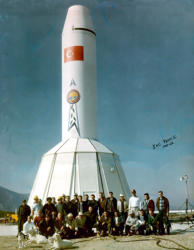HISTORY - Page 33
Air Force-Army Employment Concept Differences
The Army recognized that a large degree of the planned mobility for the system would be lost, for the Air
Force method was, by and large, to operate from fixed installations. In this respect, the Air Force planned
to gain an initial operational capability (IOC) with the IRBM's against enemy airfields and thereby enhance
the penetration ability of manned bombers to win the airpower battle. As the battle progressed, the
IRBM's would be launched against secondary targets within range, accuracy, and warhead yield
limitations. In other words, the missiles would serve as adjuncts to Strategic Air Command (SAC) bases,
and the launching sites would be satellited around these installations. As might be suspected, swift
reaction within a 15-minute period was a must because these static-type launching sites would certainly
be located by enemy reconnaissance. This meant that servicing, orientation, and checkout of the missile
prior to launching would have to be accomplished rapidly. The element of success depended on hitting the
enemy sites first.
To the Army, this thinking was a calculated risk. World War II V-l and V-2 lessons had shown that vulnerable
static positions were ineffective as missile launching sites but that the mobile mode had been effective.
Besides, there were political implications to be considered. NATO countries were already hosts to
numerous static installations and the addition of fixed missile launching sites would contribute to the
threat of atomic devastation. On the other hand, highly mobile units would be practically impossible to
locate and would serve as an able deterrent to an enemy strike
44
. Be that as it might, the Army
development team remained responsive to Air Force requirements.
_____________________________
44. Draft, JUP Brochure forwarded to Chf, R&D, DA, c. Jan 57, Hist Off files.










Jupiter SM-78 Weapon System
I&C Team 2, Çigli AB, Turkey 1961-1962 Chrysler Corporation Missile Division

HISTORY - Page 33
Air Force-Army Employment Concept Differences
The Army recognized that a large degree of the
planned mobility for the system would be lost, for the
Air Force method was, by and large, to operate from
fixed installations. In this respect, the Air Force
planned to gain an initial operational capability (IOC)
with the IRBM's against enemy airfields and thereby
enhance the penetration ability of manned bombers
to win the airpower battle. As the battle progressed,
the IRBM's would be launched against secondary
targets within range, accuracy, and warhead yield
limitations. In other words, the missiles would serve as
adjuncts to Strategic Air Command (SAC) bases, and
the launching sites would be satellited around these
installations. As might be suspected, swift reaction
within a 15-minute period was a must because these
static-type launching sites would certainly be located
by enemy reconnaissance. This meant that servicing,
orientation, and checkout of the missile prior to
launching would have to be accomplished rapidly. The
element of success depended on hitting the enemy
sites first.
To the Army, this thinking was a calculated risk. World
War II V-l and V-2 lessons had shown that vulnerable
static positions were ineffective as missile launching
sites but that the mobile mode had been effective.
Besides, there were political implications to be
considered. NATO countries were already hosts to
numerous static installations and the addition of fixed
missile launching sites would contribute to the threat
of atomic devastation. On the other hand, highly
mobile units would be practically impossible to locate
and would serve as an able deterrent to an enemy
strike
44
. Be that as it might, the Army development
team remained responsive to Air Force requirements.
_____________________________
44. Draft, JUP Brochure forwarded to Chf, R&D, DA, c. Jan 57, Hist Off files.





















